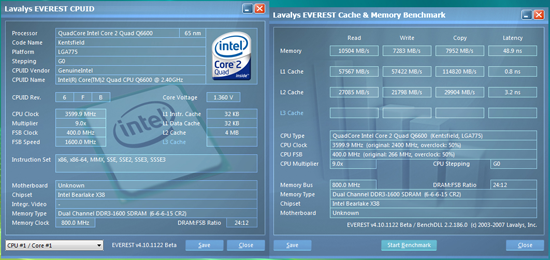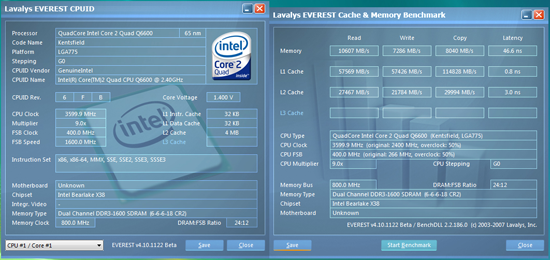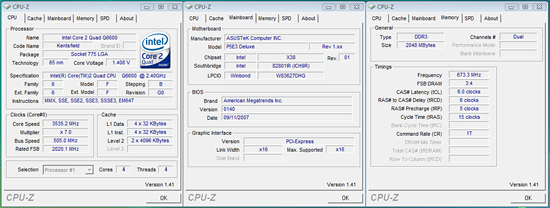ASUS P5E3 Deluxe: X38 and DDR3 arrives... almost
by Gary Key on September 18, 2007 4:00 AM EST- Posted in
- Motherboards
Memory Testing
The Sandra unbuffered scores on the Gigabyte X38 DDR2 board are around 2% better than the ASUS X38 DDR3 board and about 4% better than the abit P35 board. Our Gigabyte board is a production sample board with an early release BIOS. The scores have dropped about 1% from the engineering board we tested previously, although Gigabyte confirms that the BIOS is not fully tuned yet.
We did not expect the memory performance of DDR3 to be this close to the DDR2 board as we noticed significant differences on the P35 boards when running DDR3 at 1066. Intel and the board manufacturers have repeatedly said the X38 chipset will show improved performance with DDR3, especially with the 1333MHz FSB CPUs that allow DDR3 to run at stock 1333MHz rates. The latest BIOS spins show this trend and hopefully the retail releases will show the same progress we have noticed over the past couple of days. However, the price differential between the two memory technologies still means the DDR3 boards will be relegated to the very high end of the market for the near future.
Q6600 9x266
Q6600 9x333
Q6600 9x400
Our memory results are very preliminary considering the beta nature of the latest 1.4 BIOS. We are not showing comparisons to the other DDR3 boards until the BIOS is finalized, but at this time it appears performance is generally a few percent better than the X38 DDR2 boards. In the 9x400 results, the top screenshot is with the system set to the 400 strap and the bottom screenshot is with the 333 strap setting. The improvements in chipset latencies result in slightly better read/write/copy numbers and memory latency is improved about 5%, although tRAS timings were increased from 15 to 18. However, we had to increase our MCH voltage by .04V and CPU voltage from 1.375V to 1.41875V.
Speaking of CPU voltages, we had no issues completing our entire benchmark test suite with our Q6600 set to 1.1500V at stock settings, 1.19375V at 9x333, 1.3750V at 9x400, and 1.44375V at 7x505. Even though we are not at liberty to discuss overclocking results at this time, we do have permission to show our top FSB overclock with the Q6600.
We were able to reach a final FSB setting of 505 with our Q6600. This required the 400 strap setting, MCH voltage to 1.77V, and several other BIOS settings that we will discuss in the launch article. The board actually posted our Q6600 at 522FSB, but benchmark stability was not reached until the 505FSB level. We hit 498FSB with 4GB of memory and the same settings. Hopefully the latest chipset spin and BIOS tweaks will improve upon this result. Vdroop averaged around .02~.04V throughout testing with CPU Voltage Damper enabled; without it, we noticed Vdroop around .07V~.09V when overclocking a quad-core CPU.
 |
| Click to enlarge |
The Sandra unbuffered scores on the Gigabyte X38 DDR2 board are around 2% better than the ASUS X38 DDR3 board and about 4% better than the abit P35 board. Our Gigabyte board is a production sample board with an early release BIOS. The scores have dropped about 1% from the engineering board we tested previously, although Gigabyte confirms that the BIOS is not fully tuned yet.
We did not expect the memory performance of DDR3 to be this close to the DDR2 board as we noticed significant differences on the P35 boards when running DDR3 at 1066. Intel and the board manufacturers have repeatedly said the X38 chipset will show improved performance with DDR3, especially with the 1333MHz FSB CPUs that allow DDR3 to run at stock 1333MHz rates. The latest BIOS spins show this trend and hopefully the retail releases will show the same progress we have noticed over the past couple of days. However, the price differential between the two memory technologies still means the DDR3 boards will be relegated to the very high end of the market for the near future.
Q6600 9x266
 |
| Click to enlarge |
Q6600 9x333
 |
| Click to enlarge |
Q6600 9x400
 |
| Click to enlarge |
 |
| Click to enlarge |
Our memory results are very preliminary considering the beta nature of the latest 1.4 BIOS. We are not showing comparisons to the other DDR3 boards until the BIOS is finalized, but at this time it appears performance is generally a few percent better than the X38 DDR2 boards. In the 9x400 results, the top screenshot is with the system set to the 400 strap and the bottom screenshot is with the 333 strap setting. The improvements in chipset latencies result in slightly better read/write/copy numbers and memory latency is improved about 5%, although tRAS timings were increased from 15 to 18. However, we had to increase our MCH voltage by .04V and CPU voltage from 1.375V to 1.41875V.
Speaking of CPU voltages, we had no issues completing our entire benchmark test suite with our Q6600 set to 1.1500V at stock settings, 1.19375V at 9x333, 1.3750V at 9x400, and 1.44375V at 7x505. Even though we are not at liberty to discuss overclocking results at this time, we do have permission to show our top FSB overclock with the Q6600.
 |
| Click to enlarge |
We were able to reach a final FSB setting of 505 with our Q6600. This required the 400 strap setting, MCH voltage to 1.77V, and several other BIOS settings that we will discuss in the launch article. The board actually posted our Q6600 at 522FSB, but benchmark stability was not reached until the 505FSB level. We hit 498FSB with 4GB of memory and the same settings. Hopefully the latest chipset spin and BIOS tweaks will improve upon this result. Vdroop averaged around .02~.04V throughout testing with CPU Voltage Damper enabled; without it, we noticed Vdroop around .07V~.09V when overclocking a quad-core CPU.










60 Comments
View All Comments
DigitalFreak - Tuesday, September 18, 2007 - link
Funny thing is, there were quite a few boards a year or two ago that had Firewire 800 (mainly from Gigabyte). Not sure why everyone is going back to Firewire 400.Gary Key - Tuesday, September 18, 2007 - link
Gigabyte use to have Firewire 800 and from all indications about a dozen (me included) people cared about it according to their marketing group, plus the cost was about double for the chipset. After speaking, sometimes pleading, the motherboard manufacturers are going to stick with Firewire 400 for the time being, originally most of the new boards were not going to have it.Hulk - Tuesday, September 18, 2007 - link
It's great to compare this new chipset to other current designs but a lot of people, like myself, are considering an upgrade from older designs. I have a P5B Deluxe and would like to see a 965 based chipset in the performance graphsgramboh - Tuesday, September 18, 2007 - link
I'm also a P5B Deluxe owner and I don't see much benefit to moving to P35/X38 at all. There might be a 3-5% performance boost and potentially better overclocking, but really nothing is different.I plan to wait for the next generation MB's and for DDR3 prices to drop. I might then upgrade my mainboard/memory in late 2008/early 2009.
FWIW I plan to drop in a 45nm Penryn quad core into my P5B-Deluxe in summer 2008.
Gary Key - Tuesday, September 18, 2007 - link
We will have comparisons to the older boards in the launch article, well, the article that will contain retail boards. Right now, our first retail board with the revised X38 will not arrive until this Friday. Monday might be just be a fluff PR article on the chipset specifics until we get at another board or two in.hifisoftware - Tuesday, September 18, 2007 - link
Good review.It's good to see DDR3 reviews once in a full moon (just to know where it stands performance wise), but 99% of people would rather see DDR2 review. DDR3 is just way, way more expensive without providing anything in return. I am looking for a new system so I want to know whether I should go with P35 or X38? Sounds like X38 will be more expensive and not much better (I do not care about running cooler, unless it can be translated to a higher overclock)
JarredWalton - Tuesday, September 18, 2007 - link
The quad-core FSB OC results are quite a bit higher than anything we've seen so far. Many quad cores have issues running at FSBs beyond the low 400MHz range. Then again, with the lowest quad-core having a 9X multiplier, I don't really see this as a huge limitation.hifisoftware - Tuesday, September 18, 2007 - link
Thanks. I guess then there is a reason for me to wait 2-3 weeks to decide if X38 price justifies it's OC abilities.n0nsense - Tuesday, September 18, 2007 - link
In your case will be smarter to wait for chipsets with PCIe 2 support.not to mention soon coming HybridSLI with 1600MHz support from Nvidia and X48 from intel.
and the Phenoms triple and quad cores will be released. Many new technologies. If it's not broken, let it work another half year.
n0nsense - Tuesday, September 18, 2007 - link
The passive cooling solution is good, but have some problem.The problem starting when you install this heatpipe cooled boards into cases like Enermax CS-718 (http://rusisrael.com/albums/pic/o/00/00/28/2863.jp...">http://rusisrael.com/albums/pic/o/00/00/28/2863.jp.... According to Asus support, "After all, the board is not designed to be installed "upside-down"" and they suggest to consider other cooling solutions in case of overclocking. It took me more then a week to get straight answer for the question "Does installation direction have negative affect on cooling". The question was asked about my P5N32-E SLI, but i suspect it remains true for all boards with heatpipe cooling solution. What is disappointing me most, is the fact that this information not found on Asus's site as "case compatibility" or "installation directions" or some other kind of note or warning.